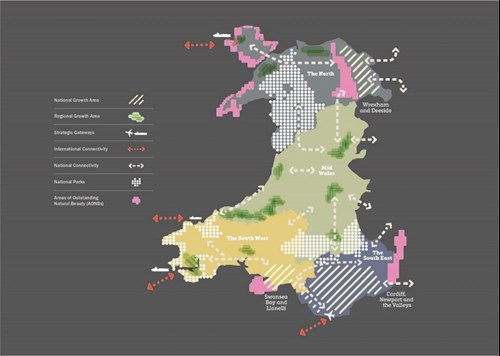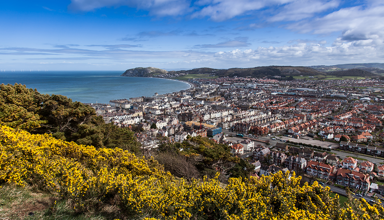The Senedd is debating the Welsh Government’s first National Development Framework (NDF) on Tuesday 29 September 2020.
This post answers some frequently asked questions and links to the key documents.
What is the NDF and why is it important?
The NDF is a new 20 year national spatial strategy. It sets out the Welsh Government’s policies on development and land use in a spatial context and will be known as ‘Future Wales: the national plan 2040’.
It’s important because it has ‘development plan’ status.
This means planning decisions must be made in accordance with the NDF, and the plans that sit below it - regional Strategic Development Plans (SDPs) (which have yet to come forward) and Local Development Plans (LDPs) – must be consistent with it.
The NDF’s predecessor – the Wales Spatial Plan – didn’t have development plan status.
The NDF is required under the Planning (Wales) Act 2015 and must be reviewed at least every five years.
It will sit alongside Planning Policy Wales (PPW) – the Welsh Government’s national planning policy - at the top of the planning policy hierarchy.
How is the Senedd scrutinising the NDF?
The Act requires the Welsh Government to lay the draft NDF before the Senedd for a 60 day ‘consideration period’. The draft NDF must be accompanied by a report summarising the issues raised during the consultation process and how the Welsh Government has taken them into account.
The Minister for Housing and Local Government, Julie James, laid the draft NDF and the consultation report before the Senedd on 21 September, and in doing so started the clock ticking on the 60 day period.
In her statement she said the NDF will “help deliver decarbonisation, ecosystem resilience and inclusive, fair economic growth.”
She also published a number of other documents including a schedule of changes to the draft NDF document that was consulted upon in 2019 and a document setting how the NDF is to be monitored.
The Senedd can’t ‘approve’ the NDF. Rather, the Welsh Government must take account of any resolution or recommendations made by the Senedd, or any of its committees, in deciding whether or not the draft NDF should be amended. It must publish a statement alongside the final NDF outlining how it has considered the Senedd’s resolutions or recommendations.
The Senedd debate on 29 September has been instigated by the Welsh Government.
The Senedd’s Climate Change Environment and Rural Affairs (CCERA) Committee plans to hold a scrutiny session with the Minister on 15 October and an evidence-gathering session with stakeholders on 5 November.
This will be followed by a further Senedd debate (date to be confirmed), this time instigated by the Committee, when Members of the Senedd will have the opportunity to debate the Committee’s findings.
The Welsh Government intends to publish the final NDF in February 2021.
What are the main policies in the NDF?
The policies in the draft NDF include:
- three ‘National Growth Areas’ for significant employment and housing growth, and investment in infrastructure:
- Cardiff, Newport and the Valleys;
- Swansea Bay and Llanelli; and
- Wrexham and Deeside.
- three ‘Regional Growth Areas’ to complement the National Growth Areas:
- The South West;
- Mid Wales; and
- The North.
- four regions, each with its own SDP;
- each region has its own allocation for new homes by 2039 (these numbers are estimates based on current data not a requirement or a target):
- North - 16,200;
- Mid Wales - 1,800;
- South West - 25,600; and
- South East - 66,400.
- 48% of new homes across Wales to be affordable homes during the first five years;
- a town centre first approach, and shaping urban growth and regeneration through placemaking and public sector leadership;
- enhancing regional, national and international transport connectivity;
- supporting large and small scale renewable and low carbon energy;
- supporting digital communications;
- managing flood risk;
- supporting rural communities and the rural economy; and
- a national forest, a Valleys regional park; greenbelts and resilient ecological networks and green infrastructure.
What does the NDF ‘map’ look like?
The draft NDF strategic diagram looks like this:

How has the NDF been developed?
Work to develop the NDF began in 2016. The Welsh Government has published a timeline showing the stages involved in developing the NDF. This includes:
- developing a Statement of Public Participation (January – September 2016);
- gathering evidence and undertaking engagement to develop the vision, objectives and options for the NDF (October 2016 – March 2018);
- publishing and consulting on issues, options and the ‘NDF preferred option’, supported by environmental reports and assessments (April 2018 – July 2018);
- considering responses to the preferred option consultation and preparing the draft NDF (July 2018 – August 2019);
- consulting on the draft NDF, considering responses and preparing the consultation report (August 2019 – June 2020);
- the Senedd considering the draft NDF and proposed changes (September – November 2020); and
- publishing the final NDF (February 2020).
How has the Senedd scrutinised the NDF so far?
The CCERA Committee scrutinised the NDF preferred option in June 2018. The Committee then wrote to the Minister (PDF, 157KB) seeking clarification on a range of issues. The Minister responded (PDF, 351KB) in September 2018.
The Committee then scrutinised the draft NDF in late 2019. This included evidence sessions on 24 October, 6 November and 14 November. The Committee’s report (PDF, 1MB), published in December, drew 50 conclusions. The Welsh Government’s substantive response to the Committee’s conclusions is included in the consultation report laid on 21 September.
The Economy, Infrastructure and Skills (EIS) Committee also scrutinised the draft NDF, in November 2019, and wrote to the Minister. Again, the Welsh Government’s response is included in the consultation report.
Senedd Research published this research briefing to support the Committees’ scrutiny of the draft NDF.
We also commissioned Ludi Simpson, Professor of Population Studies at the University of Manchester, under the Senedd Research Fellowship Scheme, to review the housing estimates in the draft NDF.
How has the draft NDF changed following scrutiny?
The Welsh Government accepted 47 of the CCERA Committee’s 50 conclusions, albeit 22 of them in principle only. It accepted one conclusion in part and rejected the other two.
Significant changes to the draft NDF that are consistent with the Committee’s conclusions include:
- clearer links to other Welsh Government documents, such as Low Carbon Wales, the Transport Strategy and the Wales Infrastructure Investment Plan;
- providing more detail about how the NDF will be monitored and reviewed;
- strengthening the NDF in terms of responding to climate change, for example by including a new policy on flood risk management; and
- greater emphasis on a criteria based approach to renewable energy developments.
The EIS Committee was concerned by the draft NDF’s “lack of ambition”, but the Welsh Government strongly rejected this assessment saying that the NDF includes policies to deliver “radical improvements to how places look and function”.
The Welsh Government did accept the Committee’s concerns around the lack of progress at the regional level saying that the Local Government and Elections (Wales) Bill will mandate preparation of SDPs. The Welsh Government also agreed with the Committee’s comments on strengthening transport connections within Wales and between Wales and elsewhere.
Both Committees preferred dividing Wales into four regions rather than the three regions originally proposed. The Welsh Government agreed with this.
The detail of how effectively these changes have been incorporated into the amended NDF will no doubt be teased out during the scrutiny process in coming weeks.
Article by Elfyn Henderson, Senedd Research, Welsh Parliament






